Bonorong Wildlife Sanctuary: Rescuing The Wildlife Of Tasmania And Australia. And Educating Us On It's Continued Survival
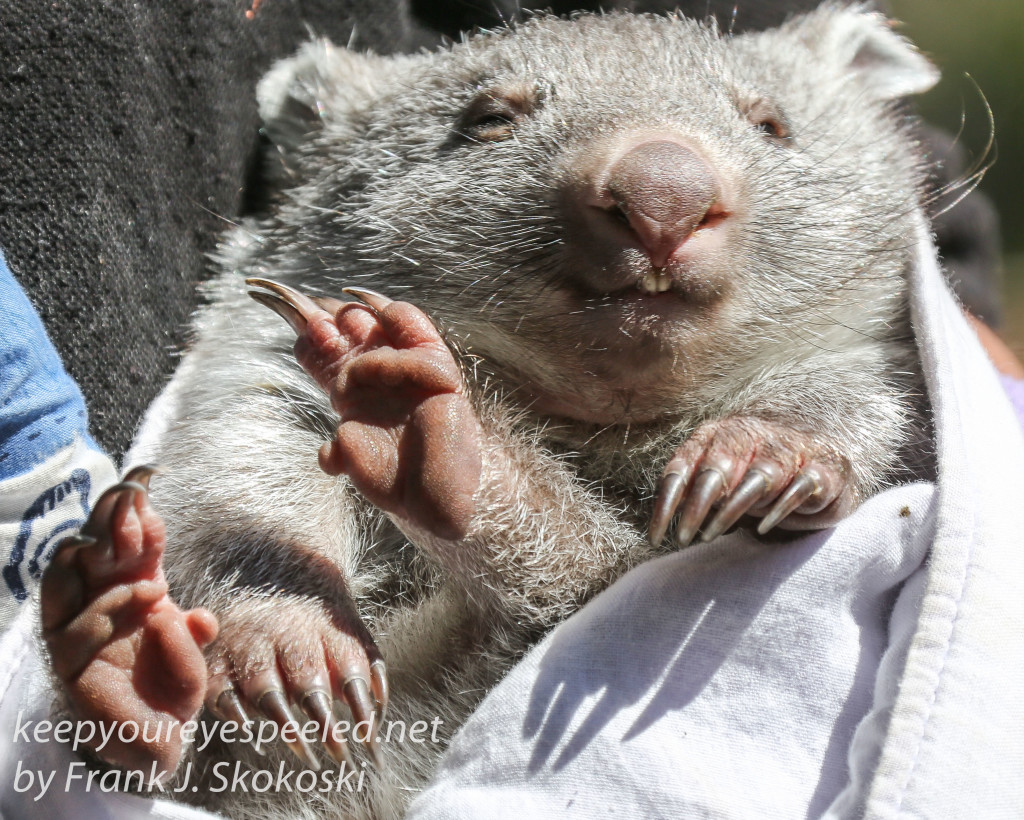
<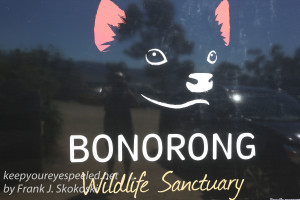
After visiting Africa two years ago I came to realize animals were not created to be held captive. I could see the expressions of joy in the families of elephants roaming the vast Serengeti plain, free to travel anywhere is search of food, lions roaming the African plains or giraffes chomping on leaves, as free as they day they were born. I will no longer visit zoos. Animals do not belong in these cages. The Bonorong Wildlife Sanctuary is not a zoo. It is a sanctuary for injured, ill or abandoned animals. I And what a wonderful sanctuary it is.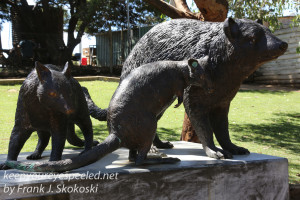
Once again time was my enemy and I only had two hours to spend in this haven for Australia’s wildlife. I learned from some of the exhibits and pamphlets that the sanctuary is funded completely by admissions and private contributions. It’s hundreds of volunteers rescue hundreds of animals injured in encounters with motor vehicles. Tasmania, since it has so much wilderness areas also has more roadkills than anywhere else in the world. Many young “joeys”, still in their mothers pouches are orphaned and, would surely die, if not for the volunteers at this safe haven, which also has it’s own animal hospital. Conservation is also emphasised at Bonorong Wildlife Sanctuary. (Please right click on the red highlighted words for a link for more information about the sanctuary)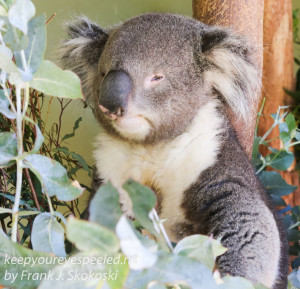
I entered the sanctuary and after a short walk, opened a gate and was greeted by the sight of hundreds of kangaroos. It was amazing to be so close to these exotic animals.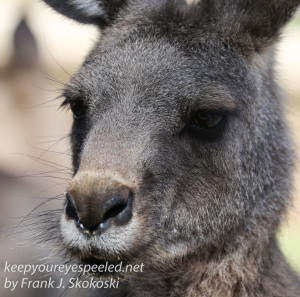
The kangaroos are remarkably friendly and you are able to hand feed them with food provided by the sanctuary. They were all so much alike yet different in their personalities. And after a while I was able to notice the many differences, in the size of one’s ears, tail or paws.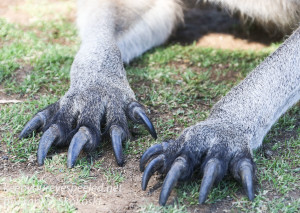
There were old timers, content to lay in the warm Summer sun, young ones frolicking about and moms nursing their young. I spent what was way to short of a time but had to see the rest of the sanctuary. Here is a link to some more photographs of the many kangaroos I saw that afternoon. https://www.keepyoureyespeeled.net/australia/nggallery/australia/australia-day-eighteen-tasmania-bonorong-wildlife-sanctuary-kangaroo-february-21-2016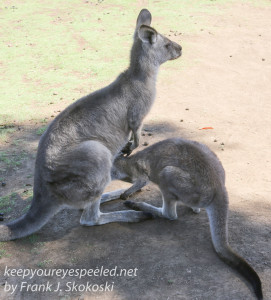
I left the kangaroo area and came face to face with these large birds, the emus. It sure would take a lot of bird seed to keep this birds full. Again, I was able to get very close and observe these massive birds. I sure can see their relation to the dinosaur. Here is a link to some more photographs of the emus. https://www.keepyoureyespeeled.net/australia/nggallery/australia/australia-tasmania-bonorong-wildlife-sanctuary-emu-february-21-2016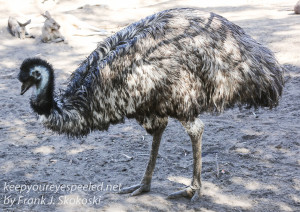
I next got to see the critter I most associated with Tasmania, the famous tasmanian devil. At first it appeared nothing like the ferocious animal portrayed in Bugs Bunny cartoons. It actually was kind of cute resting in the sun.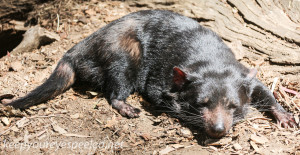
However, once it got up and started pacing about it showed it’s true colors, and teeth, and showed us how this marsupial got it’s name. Unfortunately, a cancer has spread through the population, they are only found on the island of Tasmania, and there species is now endangered. Here is a link to some more photographs of the strange and exotic creature. https://www.keepyoureyespeeled.net/australia/nggallery/australia/australia-day-eighteen-tasmania-bonorong-wildlife-sanctuary-tasmanian-devil-february-21-2016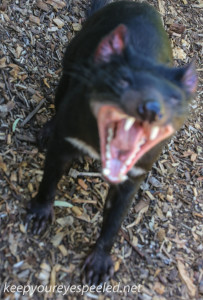
I next came upon what I think is the most famous, and beloved of all of Australia’s many exotic animals the koala. And I can see why. They sure do look cute. I learned, on my travels through Australia, that there are over seven hundred different species of eucalyptus trees in Australia. I also learned that koalas only eat eucalyptus leaves. The problem for this remarkable creatures is that they only eat around six of the seven hundred of species. Not good for the koala which are limited to those areas where this species grow.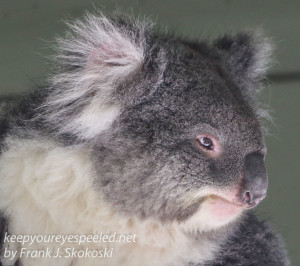
There are no koalas in tasmania, nor any of the species of eucalyptus trees they eat, so all of their food must be flown in from the mainland. They are not a very energetic animal but I was lucky to have one of them make a move down the tree while I watched. The other fellow was content sleeping. Here is a link to some more photographs of the koalas. https://www.keepyoureyespeeled.net/australia/nggallery/australia/australia-tasmania-bonorong-wildlife-sanctuary-koala-february-21-2016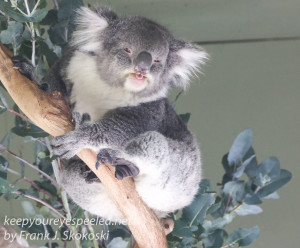
There were a number of different species of birds, most parrot like, in the sanctuary, and, although , I visited all of them, I didn’t have time to wait for them to get in good positions for photographs. Here is a link to some of the better photographs I was able to get of the birds. https://www.keepyoureyespeeled.net/australia/nggallery/australia/australia-day-eighteen-bonorong-wildlife-sanctuary-birds-february-21-2016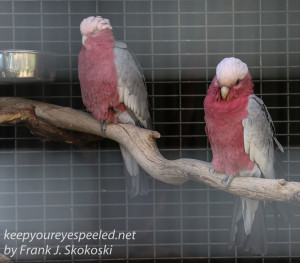
I also visited the blue tongued lizards and waited patiently for them to show me their tongue. They weren’t co-operating but I did manage to at least get this photograph. Here is a link to some more photographs of the lizards. https://www.keepyoureyespeeled.net/australia/nggallery/australia/australia-tasmania-bonorong-wildlife-sanctuary-blue-tongued-lizard-february-21-2016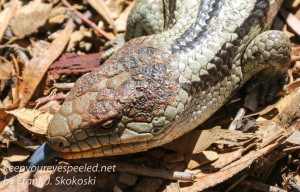
And next there was Randall, a three footed echidna or anteater. He lost a foot and couldn’t survive on his own in the wild.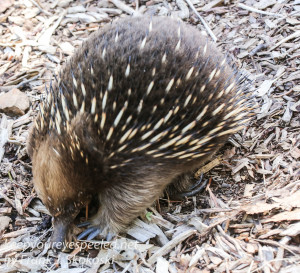
Thankfully, someone brought him to the sanctuary and he is happy roaming it’s grounds looking for a meal. Here is a link to some more photographs of Randall. https://www.keepyoureyespeeled.net/australia/nggallery/australia/australia-tasmania-bonorong-wildlife-sanctuary-february-21-2016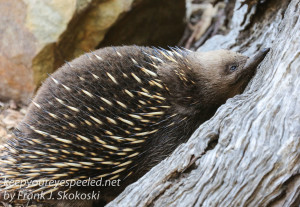
Finally I came to the wombats and this baby that was rescued and brought to the sanctuary. Thankfully, because of the many volunteers at the sanctuary this cute little creature has a chance to survive after the loss of it’s mother. Here is a link to some more photographs of the wombats. https://www.keepyoureyespeeled.net/australia/nggallery/australia/australia-tasmania-bonorong-wildlife-sanctuary-wombat-february-21-2016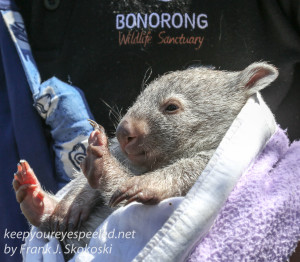
Randall and this baby wombat’s stories are the same as many other animals at this, and other sanctuaries around the world, not only do they save individual animals like the echidna, or the baby wombat, but they allow us to see these wonderful creatures up close. And familiarity with this beautiful creatures, who share this planet with us, and are just as much a part of it as we are, helps us understand how perilous their situation is and teach us ways we can help protect them. It is a good thing, both for us and the animals. 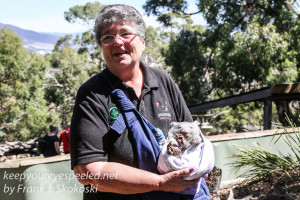
“If we can teach people about wildlife, they will be touched. Share my wildlife with me. Because humans want to save things that they love.”
― Steve Irwin
Y
]]>
Categories
Recent Comments